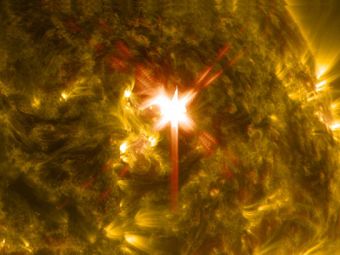Solar Spectacle: What the Recent X-Class Solar Flare Means for Earth and Space
The Sun, our closest star, is more than just a source of light and heat—it’s a powerful engine of energy that occasionally reminds us of its explosive potential. Let’s explore what makes this flare so important, the science behind solar flares, the critical role of NASA’s SDO, and how we can prepare for future solar activity.
The X1.3 Solar Flare Event: A Powerful Burst from Our Sun
On September 12, 2024, a powerful X1.3-class solar flare erupted from the Sun, peaking at 5:43 a.m. ET. This flare, captured by NASA’s Solar Dynamics Observatory, stands out due to its intensity. X-class flares are the most powerful type of solar flare, with the potential to disrupt satellites, navigation systems, and even electrical grids on Earth. An X1.3 flare falls on the higher end of this scale, indicating a significant release of magnetic energy that had built up in the Sun’s atmosphere.
NASA’s SDO captured this event in extreme ultraviolet light, providing a vivid image of the flare’s hot, glowing material. The intensity of an X1.3 flare means that it is not just a fleeting moment in space; it has real consequences for our technological infrastructure and space-based operations.
The Impact of X-Class Solar Flares on Earth
Solar flares, especially those classified as X-class, can have profound effects on Earth. These powerful bursts of radiation can interfere with satellite communications, disrupt GPS navigation, and impact power grids. For example, a strong solar flare could overload transformers in power stations, potentially causing blackouts over large areas. Moreover, X-class flares can pose significant hazards to astronauts by exposing them to harmful radiation levels, a concern that becomes more pressing as space exploration missions increase.
Recent studies and observations have confirmed that solar flares can indeed cause such disruptions. For instance, the March 1989 solar storm led to a nine-hour power outage in Quebec, Canada, affecting millions of people.
NASA’s Solar Dynamics Observatory: The Eye in the Sky
NASA’s Solar Dynamics Observatory (SDO) plays a pivotal role in our ability to study and understand solar activity. Launched in 2010 as part of NASA’s Living With a Star (LWS) program, the SDO is equipped with advanced instruments designed to measure the Sun’s magnetic field, photograph its surface, and analyze the solar ultraviolet output. Its key instruments, including the Atmospheric Imaging Assembly (AIA), the Helioseismic and Magnetic Imager (HMI), and the Extreme Ultraviolet Variability Experiment (EVE), provide invaluable data for solar physics research.
The SDO’s mission is critical for improving space weather forecasts, which are essential for safeguarding our technological infrastructure and space missions. By continuously monitoring the Sun’s activity, the SDO helps scientists detect solar flares and coronal mass ejections (CMEs) early, allowing for timely warnings and preparations.
The Science Behind Solar Flares and Their Classification
Solar flares are intense bursts of radiation resulting from the sudden release of magnetic energy stored in the Sun’s atmosphere. When magnetic fields in the Sun’s atmosphere become twisted and tangled, they can release a massive amount of energy in the form of a solar flare. These flares are classified by their brightness in the X-ray wavelengths, from A (smallest) to X (largest). Within each class, a finer scale from 1 to 9 is used to indicate the flare’s intensity. An X1.3 flare, therefore, is a significant event, capable of causing substantial space weather effects.
The categorization of solar flares is crucial for understanding their potential impact. For instance, an M-class flare might cause minor radio blackouts, while an X-class flare, like the recent X1.3, could lead to widespread communication disruptions and radiation storms. Understanding these classifications helps scientists and space weather forecasters communicate the risks associated with different levels of solar activity more effectively.
How X-Class Solar Flares Affect Space Weather and Earth’s Infrastructure
When a solar flare erupts, it sends a stream of charged particles toward Earth, which can interact with the planet’s magnetic field and atmosphere. These interactions can lead to geomagnetic storms, which can disrupt satellites, power grids, and radio communications. For example, solar flares can cause GPS signals to degrade, affecting everything from airplane navigation to smartphone location services.
The potential for such disruptions highlights the importance of space weather forecasting. Just as we monitor weather patterns on Earth, scientists use data from the SDO and other observatories to predict space weather events. The ability to forecast these events allows for protective measures, such as temporarily shutting down vulnerable satellites or adjusting flight paths for high-altitude aircraft.
Preparing for Solar Flares: Mitigation Strategies and Future Technologies
Given the potential impacts of solar flares, it is crucial to have strategies in place to mitigate their effects. Current mitigation strategies include hardening satellites against radiation, developing more resilient power grids, and creating better space weather forecasting models. For astronauts, spacecraft can be equipped with radiation shields, and missions can be planned to avoid periods of high solar activity.
Advancements in technology also offer new ways to mitigate the risks associated with solar flares. For instance, future missions to the Moon or Mars will likely require enhanced space weather monitoring to protect astronauts from radiation exposure. Moreover, international collaboration is key to improving our ability to predict and respond to space weather events. Coordinated efforts can help share valuable data and resources, ensuring a more comprehensive understanding of solar activity and its effects.
Why This Solar Flare Matters: A Wake-Up Call for Space Weather Awareness
The X1.3 solar flare of September 12, 2024, is not just another celestial event; it is a wake-up call for increased awareness and preparedness for space weather. As our dependence on technology grows, so does our vulnerability to solar activity. From communications satellites to power grids and space missions, our modern world is intricately linked to space weather.
Moreover, as humanity embarks on more ambitious space exploration missions, understanding and mitigating the effects of solar flares becomes even more critical. The Artemis program, which aims to return humans to the Moon, and plans for future missions to Mars will require robust space weather prediction and protection measures to ensure the safety of astronauts and equipment.
Conclusion: The Power of Solar Flares and the Need for Vigilance
The X1.3 solar flare of September 12, 2024 is a powerful reminder of the Sun’s dynamic nature and its influence on Earth. As we continue to explore space and rely on satellite technology, understanding solar flares and their potential impacts is more important than ever. Through continuous monitoring, research, and international collaboration, we can better prepare for the challenges posed by space weather and harness the knowledge gained to protect our planet and future space missions.
The journey to understanding our Sun and its behavior is ongoing, and each solar flare, like the recent X1.3 event, adds a piece to the puzzle. As we look to the skies, we are reminded that our Sun, while life-giving, is also a source of immense power that must be respected and studied diligently. In doing so, we ensure a safer, more connected future for all of humanity, both on Earth and beyond.
Reference:



















